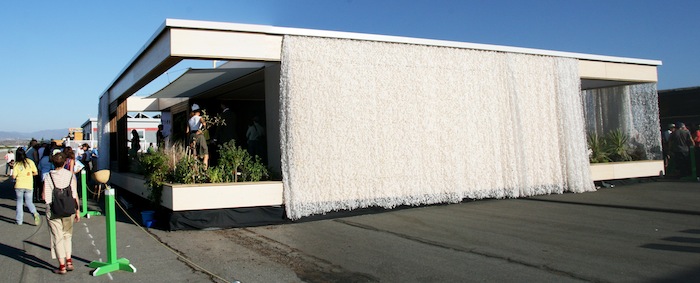The story: A students’ competition, “Solar Decathlon,” for the design of sustainable dwelling units. It is sponsored every two years by the U.S. Department of Energy. Twenty finalist groups build their version of solar-powered houses that are expected to be cost effective, energy-efficient and attractive. The results were shown in Southern California during the first two weekends of October at the Orange County Great Park. It attracted thousands of people, hungry for housing solutions.
The competing groups spend two years preparing for the event. They build and test the houses, and at the end of the process these are transported from campuses across the country and around the world to the exhibition. The projects are evaluated according to ten different criteria, five based on the jury’s judgment and five measurable. The first five are Architecture, Market Appeal, Engineering, Communications and Affordability. The measurable ones are Comfort Zone, Hot Water, Appliances, Home Entertainment and Energy Balance. The budget is $250,000 or less.

The 2013 winner was Team Austria. It was followed by the University of Nevada Las Vegas team in the second place, and by the Czech Republic team in the third place.
Team Austria built LISI (Living Inspired by Sustainable Innovation,) a house built of 93 percent timber. The house’s most striking feature is its exterior curtain. It is made of a Teflon fabric that has been cut in a pattern designed by the students but which is very robust despite its delicate appearance, and is similar to material used by the military for camouflage.
The team from the University of Nevada Las Vegas built the DesertSol house, which reflects the spirit of the Mojave Desert. Materially, it uses weathered timber and rusted metal patio screening .
The Czeck Republic team built AIR House (Affordable, Innovative and Recyclable,) designed for the generation 50+. It is made entirely of wood.
Yet “my winner” was by far the SCI/ARC- Cal Tech team, which built sustainable architecture prototype DALE (Dynamic Augmented Living Environment, seen in top photo). The students produced a design of two prefabricated modules that move across a rail system. This approach triples the inhabitable square footage, allowing for a patio between the modules when desired. Wall partitions and components move. A 28-panel photovoltaic array produces the entire house’s electricity. It is a house created with the rigor of aerospace industry engineering and an architectural aesthetic of functional minimalism.
Solar Decathlon is an important move in the right direction, but: is it promoting a sustainable sprawl at a macro-scale? The idea that one can produce houses with a low carbon footprint and then spread them across vast areas does not confront the needs of a population that, sooner or later, will reach ten billion and will be mostly urban.
Luigi Pellegrin, one of the great visionary architects of the 20th Century’s second half (little known outside of Italy) foresaw the problems that we face today in the early 1970’s. He was a man with a deep understanding of Frank Lloyd Wright’s Organic Architecture’s principles without becoming a “Wright stylist” and confronted the problems of prefabrication to bridge between quality, quantity and cost.
Pellegrin’s prescedent suggests that Solar Decathlon should push ahead one step further to find sustainable solutions for medium and high density urban environments.
Rick Meghiddo is an architect and a filmmaker. As an architect, he focuses on innovative work that is sustainable, aesthetic, and budget-conscious, looking at each project as an opportunity to rethink solutions to conventional problems. As a filmmaker, he brings his "architect eye" to help non-professionals and professionals better understand the meaning, value, and complexities of architecture and art.
Born in Argentina, he studied architecture at the University of Buenos Aires, at the Technion in Israel, and earned his M. Arch from UCLA and his Dottore in Architettura from the University of Rome. Following over three decades of practice as an architect in Los Angeles, Tel Aviv, and Rome, he produced and directed over one hundred documentaries, mostly on architecture and art.
Rick is also a registered journalist with USPA and a published poet. He is fluent in English, Spanish, Italian, Hebrew, and oral French. Selected works in architecture, photography, art, and poetry can be seen in http://meghiddoarchitects.com/ His documentaries can be seen in http://archidocu.com/ and in http://architectureawareness.com/
Born in Argentina, he studied architecture at the University of Buenos Aires, at the Technion in Israel, and earned his M. Arch from UCLA and his Dottore in Architettura from the University of Rome. Following over three decades of practice as an architect in Los Angeles, Tel Aviv, and Rome, he produced and directed over one hundred documentaries, mostly on architecture and art.
Rick is also a registered journalist with USPA and a published poet. He is fluent in English, Spanish, Italian, Hebrew, and oral French. Selected works in architecture, photography, art, and poetry can be seen in http://meghiddoarchitects.com/ His documentaries can be seen in http://archidocu.com/ and in http://architectureawareness.com/
